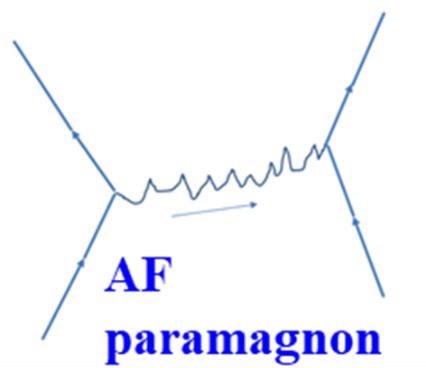Reviewed by Alex SmithMay 18 2022
The magnetic phase diagram of the high-Tc (critical temperature) superconducting material Ba2CuO4-δ and its superconducting pairing symmetry focused on the spin-fluctuation mechanism have recently been investigated by scientists led by Prof. Liangjian Zou from the Hefei Institutes of Physical Science (HFIPS) of the Chinese Academy of Sciences (CAS). Physical Review B reported the findings.
 An effective interaction mediated by exchanging an antiferromagnetic paramagnon. Image Credit: Xiaocheng Bai.
An effective interaction mediated by exchanging an antiferromagnetic paramagnon. Image Credit: Xiaocheng Bai.
Two electrons in a vacuum repel each other, as is widely known. In superconductors, however, two electrons at the Fermi surface exchange bosonic quasi-particles to form a Cooper pair. These Cooper pairs condense the superfluid with zero resistance in the same phase. Cooper pair pairing symmetry is a key property for determining successful pairing interaction in superconductors.
Ba2CuO4-δ is a recently found cuprate superconductor featured on high-Tc of 73 K, which is two to three times greater than isostructural cuprate La2CuO4-δ. It also shows compressed CuO6 octahedra, which are inverted to CuO6 octahedra or CuO5 pyramids in normal cuprate parent phases. Multiple orbitals contribute to the superconducting characteristics of Ba2CuO4-δ as a result of this.
Antiferromagnetism was found in close proximity to, and in some cases coexisting with, superconductivity in prior cuprate superconductors’ phase diagrams. As a result, it is claimed that spin fluctuation in cuprate superconductors mediates the effective pairing interaction. It is critical to analyze the magnetic phase diagram of Ba2CuO4-δ to determine which mechanism contributes to the efficient pairing interaction.
The magnetic phase diagram of the high-Tc superconducting material Ba2CuO4-δ was examined utilizing the rotationally invariant slave boson (RISB) approach in this study. Scientists also looked at the superconducting pairing symmetry in the random phase approximation, which is based on the spin-fluctuation process.
When n > 2.4, the system behaved as a single-band paramagnetic metal in the intermediate correlation domain (U ~ 2 eV), with just one antiferromagnetic insulating parent phase.
The system revealed two distinct antiferromagnetic insulating parent phases at n = 2 and 3, correlating to two-band and single-band nature, respectively, in the strongly correlated domain (U > 4 eV).
The researchers calculated that U = 2~3 eV in Ba2CuO3.2 by comparing the measured spin coupling value of roughly 150 meV with the total energy difference between the Néel antiferromagnetic and paramagnetic phases.
Researchers looked into the superconducting pairing symmetry using the spin-fluctuation mechanism and discovered that the s-wave and d-wave pairing strengths are practically degenerate.
Cooper pairs in Ba2CuO3.2 are s+d –wave symmetric, according to the findings.
It is the first time scientists have theoretically shown the magnetic phase diagram of Ba2CuO4-δ, which suggests that Cooper pairs in Ba2CuO3.2 are s+d –wave symmetric if the effective pairing interaction is driven by spin fluctuations.
The National Natural Science Foundation of China funded this research. The computations were done partially utilizing a Tianhe-2JK computing time grant at the Beijing Computational Science Research Center and partly in the HFIPS Center for Computational Science.
Journal Reference:
Bai, X-C., et al. (2022) Band crossover and magnetic phase diagram of the high-Tc superconducting compound Ba2CuO4-δ. Physical Review B. doi.org/10.1103/PhysRevB.105.184506.